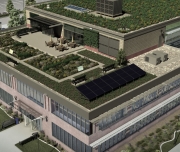The term "biophilia", meaning love of nature, is increasingly being used in high-performance building design. The goal of biomimicry is to recreate natural environments in order to increase the human/nature connection. Where organizations have integrated biomimicry into the workplace, employee satisfaction and productivity has been found to increase and the number of "sick days" decreased. Ten percent of employee absences can be attributed to architecture with no connection to nature. Additionally, building occupant health and comfort is enhanced when both air quality and temperature are properly controlled. Planted roofs contribute both directly; through filtration and regulation, and indirectly; by reducing peak energy demands and storm water overflows.
Source: Living Architecture: Green Roofs for Public Buildings
Both intensive and extensive planted roofs can create an attractive space for building occupants, and views for those in neighboring buildings. Intensive roofs in particular can offer a place of refuge and relaxation for people who work in a building, thus reducing stress and boosting worker productivity.
Source: The Benefits and Challenges of Green Roofs on Public and Commercial Buildings
Planted roofs contribute to improved air quality by capturing greenhouse gases, particulates, pollens, and molds. The vegetation on a planted roof cools ambient air temperatures and consequently promotes reductions in urban heat islands and greenhouse gas production.
Plants have long been used in the urban environment to remove air pollutants like carbon dioxide and carbon monoxide, smog-forming compounds and particulate matter. Planted roof's can improve indoor air quality by removing air pollutants near ventilation intakes. A planted roof's effectiveness at improving air quality depends on the type of plant grown and the depth of growing medium used. For example, the greater the leaf surface area, the more particulate matter can be captured.
If all of the ice located at the poles were to melt today, global sea levels would rise by 220 feet. Although this is unlikely to occur soon, scientists indicate that if average global temperatures were to go up by only a few degrees (highly likely), sea levels are expected to rise 40 feet. From studying fossils at elevated beaches, scientists can conservatively determine sea levels to rise five feet in the next 100-300 years. At this time, 6% of the San Francisco Bay will be permanently flooded. Most of this expected flooding is concentrated over the second largest estuary in the nation.
The National Oceanic and Atmospheric Administration (NOAA), predicts major shifts in weather patterns due to rising sea levels. The ocean influences changes to hurricane patterns which alters the intensity and frequency of storms. Major weather events have been consistently climbing over the past four decades.
Prevention of greenhouse gas production will reduce the quantity of CO2 being absorbed into the ocean. Green roof installations facilitate reductions in a building's carbon footprint by lowering heating and cooling energy requirements. Green roof vegetation also performs as an extremely effective carbon sink by cleansing the air of excess emissions.
Source: Living Architecture: Green Roofs for Public Buildings
Fewer emissions and the cooling of ambient air temperatures reduce the potential for ground-level ozone production. Reduced concentrations of pollutant intensities minimize opportunities for smog formation, and consequently reducing demand requirements for air conditioned space and relieving extra energy burdens of city-wide demands.
Source: Living Architecture: Green Roofs for Public Buildings

